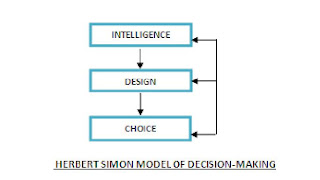HERBERT SIMON MODEL OF DECISION MAKING
HERBERT SIMON MODEL
Decision-making is a process in which the decision-maker uses to arrive at a decision. The core of this process is described by Herbert Simon in a model. He describes the model in three phases as shown in the figure below:
I. Intelligence: raw data collected, processed and examined, Identifies a problem calling for a decision.
In the intelligence phase, the MIS collects the data. The data is scanned, examined, checked and edited. Further, the data is sorted and merged with other data and computations are made, summarized and presented. In this process, the attention of the manager is drawn to all problem situations by highlighting the significant differences between the actual and the expected, the budgeted or the targeted.
In the design phase, the manager develops a model of the problem situation on which he can generate and test the different decision alternatives, he then further moves into phase of selection called as choice.
In the phase of choice, the manager evolves selection criteria such as maximum profit, least cost, minimum wastage, least time taken and highest utility. The criterion is applied to the various decision alternatives and the one which satisfies the most is selected.
In these phases, if the manager fails to reach a decision, he starts the process all over again and again. An ideal MIS is supposed to make a decision for the manager.
An example of the Simon model would illustrate further its use in the MIS. For example, a manager finds on collection and through the analysis of the data that the manufacturing plant is underutilized and the products which are being sold are not contributing to the profits as desired. The problem identified, therefore, is to find a product mix for the plant, whereby the plant is fully utilized within the raw material and the market constraints, and the profit is maximized. The manager having identified this as the problem of optimization, now examines the use of linear programming (LP) model. The model is used to evolve various decision alternatives. However, selection is made first on the basis of feasibility and then on the basis of maximum profit.
The product mix so given is examined by the management committee. It is observed that the market constraints were not realistic in some cases and the present plant capacity can be enhanced to improve the profit. The same model is used again to tool the revised position. Therefore, additional data is collected and an analysis is made to find out whether the average 20 percent utilization of the capacity can be increased. A market research for some products is made and it is found that some constraints need to be removed and reduced. Based on the revised data linear programming model is used and a better optimum solution is obtained.
MIS AND DECISION-MAKING
It is necessary to understand the concept of decision-making as they are relevant to the design of the MIS. The Simon model provides a conceptual design of the MIS and decision-making wherein the designer has to design the system in such a way that the problem is identified in precise terms. That means the data gathered for data analysis should be such that it provides diagnostics and also provide a path to bring the problem to surface.
In the design phase of the model, the designer is to ensure that the system provides models for decision-making. These models should provide for the generation of decision alternatives, test them and pave way for the selection of one of them. In a choice phase, the designer must help to select the criteria to select one alternative amongst the many.
The concept of programmed decision-making is the finest tool available to the MIS designer, whereby he can transfer decision-making from a decision-maker to the MIS and still retain the responsibility and accountability with the decision maker or the manager. In case of non-programmed decisions, the MIS should provide the decision support systems provide a generalized model of decision-making.
The concept of decision-making system, such as the closed and the open system, such as the closed and the open systems, helps the designer in providing design feasibility. The closed systems are deterministic and rule based, therefore, the design needs to have limited flexibility, while in an open system, the design should be flexible to cope up with the changes required from time to time.
The methods of decision-making can be used directly in the MIS provided the method to be applied has been decided. A number of decision-making problem calls for optimization, and operational models are available which can be made a part of the system, the optimization models are static and dynamic, and both can be used in the MIS. Some of the problems call for a competitive analysis, such as payoff analysis. In these problems, the MIS can provide the analysis based on the gains, the regrets and the utility.
The concept of the organizational and behavioral aspects of decision-making provides an insight to the designer to handle the organizational culture and the constraints in the MIS. The concepts of the rationality of a business decision, the risk awareness of the managers and the tendency to avoid an uncertainty, makes the designer conscious about the human limitations and prompts him to provide a support in the MIS to handle these limitations. The reliance on organizational learning makes the designer aware of the MIS and makes him provide the channels in the MIS to make the learning process more efficient.
The relevance of the decision-making concepts is significant in the MIS design. The significance arises out of the complexity of decision-making, the human factors is the decision-making, the organizational and behavior aspects, and the uncertain environments. The MIS design addressing these significant factors turns out to be the best design.

